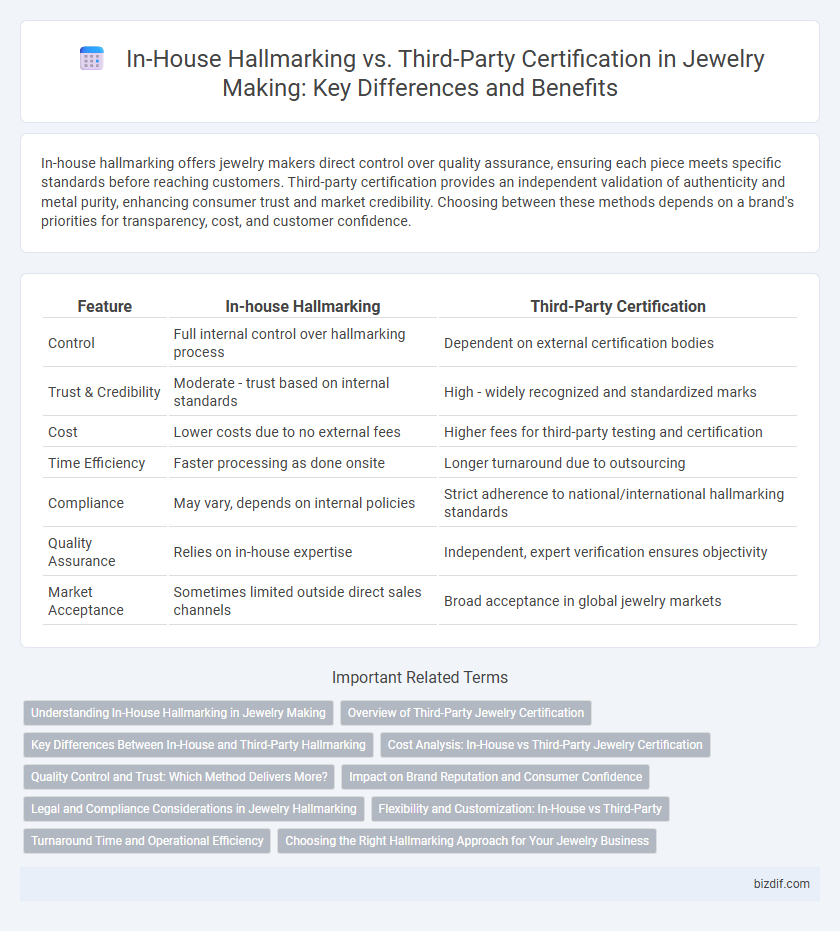In-house hallmarking offers jewelry makers direct control over quality assurance, ensuring each piece meets specific standards before reaching customers. Third-party certification provides an independent validation of authenticity and metal purity, enhancing consumer trust and market credibility. Choosing between these methods depends on a brand's priorities for transparency, cost, and customer confidence.
Table of Comparison
| Feature | In-house Hallmarking | Third-Party Certification |
|---|---|---|
| Control | Full internal control over hallmarking process | Dependent on external certification bodies |
| Trust & Credibility | Moderate - trust based on internal standards | High - widely recognized and standardized marks |
| Cost | Lower costs due to no external fees | Higher fees for third-party testing and certification |
| Time Efficiency | Faster processing as done onsite | Longer turnaround due to outsourcing |
| Compliance | May vary, depends on internal policies | Strict adherence to national/international hallmarking standards |
| Quality Assurance | Relies on in-house expertise | Independent, expert verification ensures objectivity |
| Market Acceptance | Sometimes limited outside direct sales channels | Broad acceptance in global jewelry markets |
Understanding In-House Hallmarking in Jewelry Making
In-house hallmarking in jewelry making involves artisans or manufacturers directly stamping their pieces with unique marks that certify metal purity and craftsmanship quality, enhancing brand authenticity. This process allows immediate quality control and faster turnaround compared to third-party certification, which relies on independent labs for verification. Understanding in-house hallmarking is crucial for maintaining inventory accuracy and ensuring consistent customer trust in precious metal standards.
Overview of Third-Party Jewelry Certification
Third-party jewelry certification provides independent verification of a piece's authenticity, metal purity, and gemstone quality, enhancing consumer trust and market value. Certified laboratories such as GIA, IGI, and HRD use standardized testing protocols and advanced technology to issue detailed reports that accompany the jewelry. This external validation helps protect buyers against fraud and supports transparent trading in the jewelry industry.
Key Differences Between In-House and Third-Party Hallmarking
In-house hallmarking involves internal quality control processes where jewelers verify metal purity and authenticity within their own facilities, offering faster turnaround times and direct oversight. Third-party certification requires independent, accredited laboratories to assess and certify the jewelry, providing enhanced credibility and impartial assurance of standards. Key differences include control over inspection, cost implications, and consumer trust levels, with third-party hallmarking generally seen as more reliable for guaranteeing authenticity.
Cost Analysis: In-House vs Third-Party Jewelry Certification
In-house hallmarking involves investing in specialized equipment and skilled personnel, leading to higher upfront costs but reduced per-piece expenses over time for jewelry certification. Third-party certification typically incurs lower initial expenses but charges fees per item, making it costlier for large-scale productions. Evaluating production volume and budget constraints is crucial for determining the more economical choice between in-house and third-party jewelry certification services.
Quality Control and Trust: Which Method Delivers More?
In-house hallmarking offers direct quality control by allowing jewelers to oversee the entire process, ensuring every piece meets their specific standards. Third-party certification provides an unbiased assessment, enhancing consumer trust through recognized independent verification. While in-house methods prioritize consistent craftsmanship, third-party certification often delivers greater confidence to buyers due to its external validation and industry credibility.
Impact on Brand Reputation and Consumer Confidence
In-house hallmarking allows jewelry brands to maintain strict quality control and directly associate authenticity with their name, enhancing brand reputation and fostering stronger consumer trust. Third-party certification offers independent verification that can boost consumer confidence by providing unbiased assurance of quality and purity. Choosing between the two methods significantly influences how consumers perceive a brand's credibility and authenticity in the competitive jewelry market.
Legal and Compliance Considerations in Jewelry Hallmarking
In-house hallmarking enables jewelers to maintain strict control over legal compliance by directly applying standardized quality marks, ensuring adherence to national regulations such as the BIS hallmarking standards in India or the UK's Assay Office marks. Third-party certification offers independent verification that enhances consumer trust and legal credibility, especially in jurisdictions where mandatory hallmarking laws require certified assay offices or accredited laboratories. Both methods necessitate rigorous documentation and transparency to meet anti-fraud mandates, prevent counterfeit issues, and uphold industry-wide regulatory frameworks for precious metal authenticity.
Flexibility and Customization: In-House vs Third-Party
In-house hallmarking offers greater flexibility and customization, allowing jewelers to tailor certification processes and marks to their specific branding and quality standards. Third-party certification provides standardized validation and widespread recognition but limits personalized options in hallmark design and procedural adjustments. Choosing in-house hallmarking empowers brands to maintain control over quality assurance, while third-party certification ensures impartiality and trustworthiness in the market.
Turnaround Time and Operational Efficiency
In-house hallmarking significantly reduces turnaround time by streamlining the verification process within the jewelry manufacturer's facility, enabling faster production cycles and quicker market delivery. Operational efficiency improves as there is greater control over quality checks, minimizing reliance on external agencies and associated delays. Conversely, third-party certification involves longer wait times due to external handling and shipment, which can hinder production schedules and increase operational costs.
Choosing the Right Hallmarking Approach for Your Jewelry Business
Selecting the right hallmarking approach for your jewelry business depends on factors like cost efficiency, trustworthiness, and regulatory compliance. In-house hallmarking offers greater control and faster turnaround times, while third-party certification provides unbiased verification and enhances consumer confidence. Balancing these benefits with your business scale and brand reputation ensures optimal quality assurance and market credibility.
In-house hallmarking vs third-party certification Infographic

 bizdif.com
bizdif.com